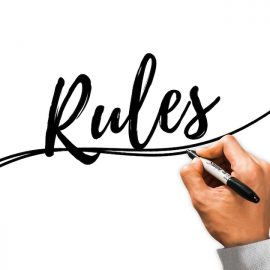

This article is an excerpt from the Shortform summary of "Influence" by Robert B. Cialdini. Shortform has the world's best summaries of books you should be reading.
Like this article? Sign up for a free trial here .
Have you ever seen a job title that really impressed you? How do you respond to instructions from someone in uniform? What do you think of someone dressed in a suit versus someone in casual clothes? Title, uniforms, and other clothing are all symbols of authority.
Symbols of authority are things like titles, uniforms, and insignia, which can all signal a person is in a position of authority. People are hard-wired to comply with requests that come from an acknowledged and accepted source of authority.
See how compliance professionals use the appearance or suggestion of authority to force you to agree to their requests.
Symbols of Authority
The Milgram experiment presents an illuminating and disturbing picture of just how far our fixed-action pattern of compliance with authority will take us. The instinct is so powerful that humans are responsive even to the mere vestiges or symbols of authority—titles, uniforms, and insignia can exert a strong influence.
But authority can also be faked or manufactured. Titles, uniforms, and other outward symbols of dominance or expertise can create the patina of authority. Naturally, compliance practitioners know how to present themselves in a way that conveys authority and expertise to their victims.
Beyond the usual mix of salespeople and politicians we’ve talked about so far, a whole variety of con men, grifters, and charlatans are quite savvy at projecting symbols of authority to force compliance.
It’s All in The Name: The Importance of Titles
Titles often have more power to direct our behavior and perceptions than the actual person claiming the title. The title is a symbol for authority.
In one Australian study, different groups of subjects rated the same person as being taller depending on the title they were told that he held. With each increase in title (student, lecturer, professor), the subjects’ perception of his height grew by half an inch! This shows the importance of title in creating the perception of other positive traits. This perhaps explains why door-to-door scammers frequently wear lifts in their shoes. Psychologically, it conveys a certain symbol for authority and gravitas.
The importance of titles and deference they’re given can have frightening effects in the medical community. One study from the Midwest demonstrated that 95 percent of nurses were willing to unquestioningly comply with orders to give dangerously high doses of medication to patients, as long as the order came from someone who claimed to be a “doctor.” Titles are symbols of authority, especially skilled professionals like doctors.
Clothing as a Symbol for Authority
Con artists know that most people will obey the orders or recommendations of someone in a uniform. Whether it’s a police uniform, military camouflage, a doctor’s lab coat, or even a snappy business suit, uniforms and modes of dress are symbols for authority.
In one experiment in Texas, researchers had a young man cross a busy intersection into oncoming traffic, to test how willing other pedestrians would be to follow him. When the young man was dressed in a freshly pressed business suit, people were 3.5 times more likely to follow him as they were when he was dressed in regular street clothes. The suit was a symbol for authority.
The “bank examiner” scam is beloved by con artists because it uses the simple power of dress to bamboozle people out of their savings. The con artist, dressed in conservative business attire, knocks on the door of the victim’s home, claiming to be a bank examiner from the victim’s financial institution. They exploit the psychological importance of titles and use symbols of authority. The con artist will claim that there has been some irregularity with the victim’s bank account, and inform the victim that a bank officer might be doing phony transactions with the victim’s money.
The victim is then asked to withdraw all their money from their account, so that the “bank examiner” can trace the record of the transaction to see if they can catch the embezzling bank officer in the act.
After the victim has withdrawn all their money, another bank official turns up at their door. This time, it’s a uniformed bank officer who reassures the victim that there was no malfeasance with their account after all. This person then offers to re-deposit the victim’s money to save them the trouble of another trip to the bank—which, of course, they never do. The scam works because the counterfeited uniforms lull the victim into compliance. The uniforms are symbols of authority.

———End of Preview———
Like what you just read? Read the rest of the world's best summary of Robert B. Cialdini's "Influence" at Shortform .
Here's what you'll find in our full Influence summary :
- How professional manipulators use your psychology against you
- The six key biases you need to be aware of
- How learning your own biases will help you beat the con men around you






